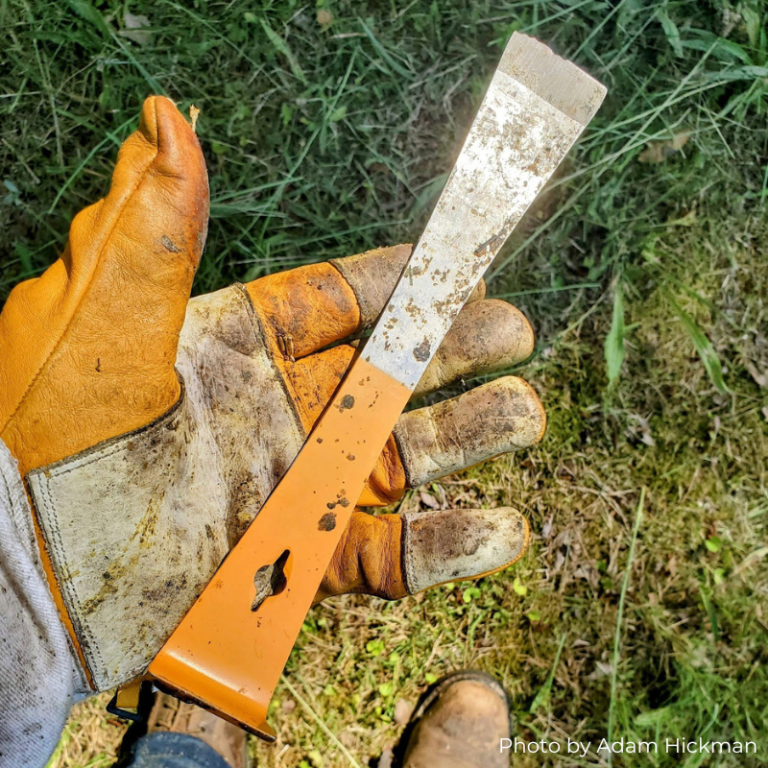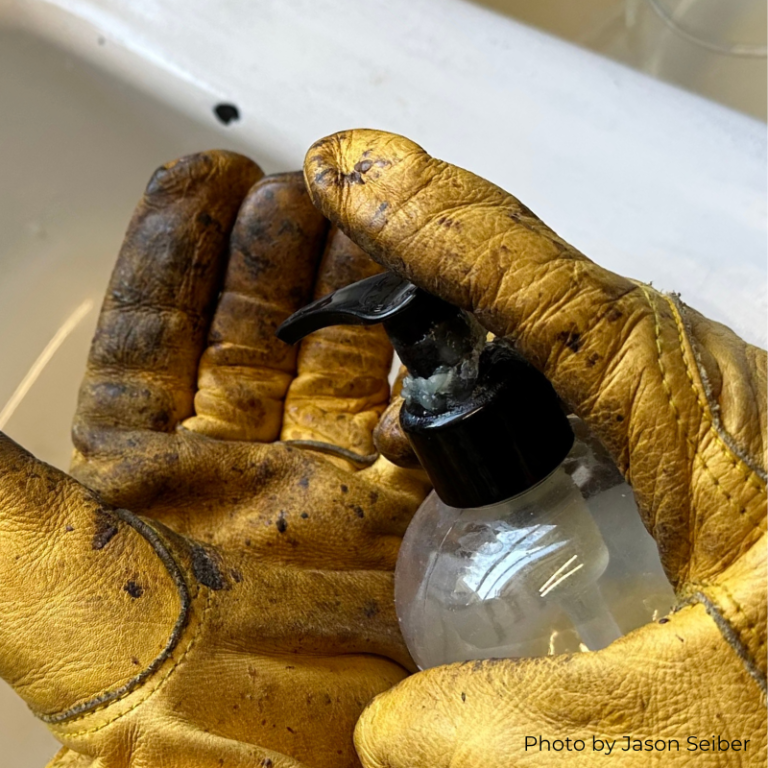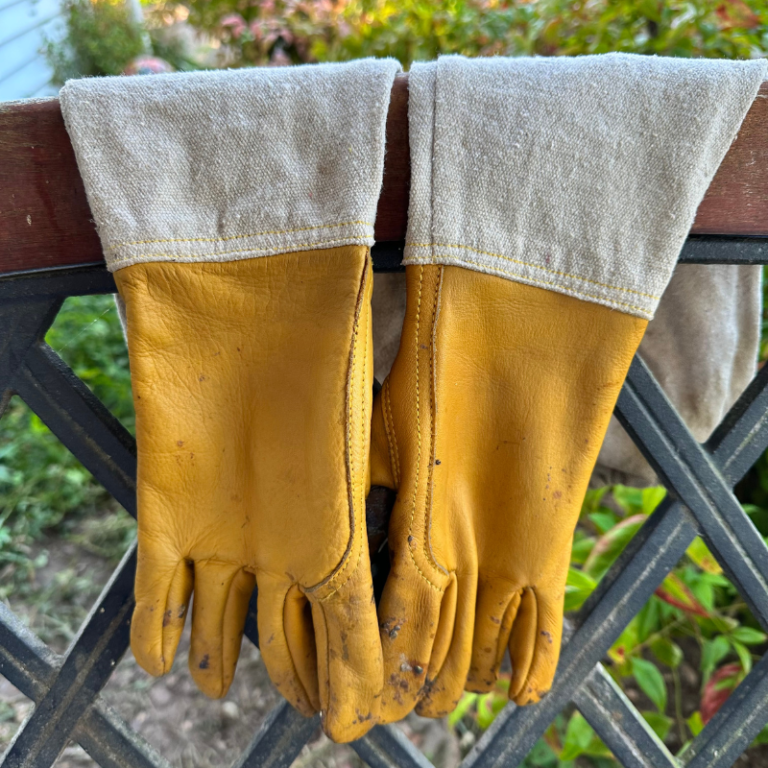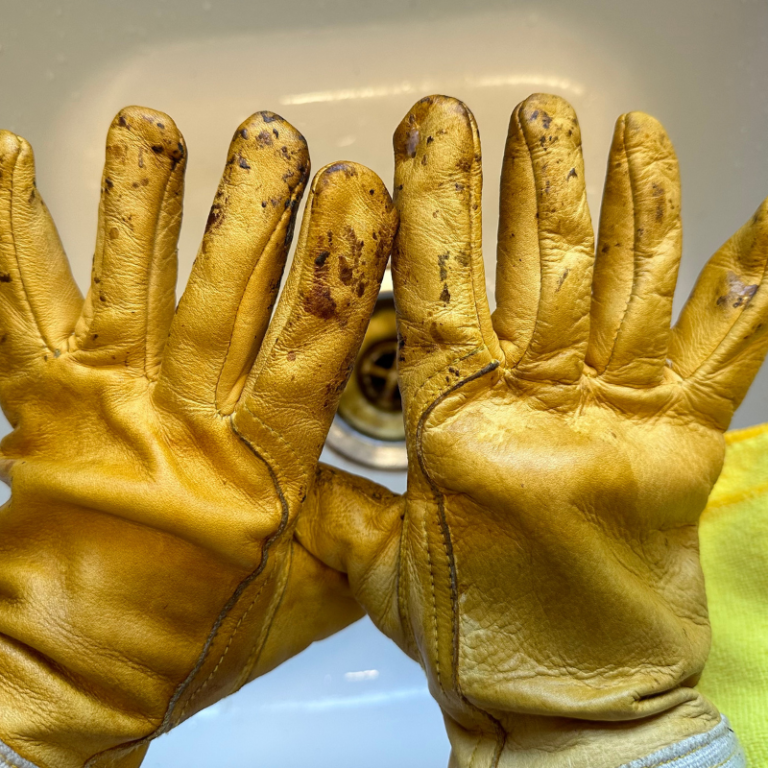

Do you use gloves when you work your bees? Most beekeepers use gloves at least part-time. Usually these gloves are made at least partly of leather.
If you have used leather gloves while working in your hives only a few times, you already know how messy your leather beekeeping gloves can get.
Substances like propolis, wax, honey, bee stingers, squished hive beetles, and mystery stains get all over them. The sooner you treat your gloves after getting stained, the better chance you have of removing the stains.
Table of Contents
Do you use gloves when you work your bees? Most beekeepers use gloves at least part-time. Usually these gloves are made at least partly of leather.
If you have used leather gloves while working in your hives only a few times, you already know how messy your leather beekeeping gloves can get.
Substances like propolis, wax, honey, bee stingers, squished hive beetles, and mystery stains get all over them. The sooner you treat your gloves after getting stained, the better chance you have of removing the stains.
Table of Contents

Cleaning Your Leather Gloves
Leather is made of animal skin and like our own skin, it needs to be maintained. You’ll get more life out of your gloves if you maintain the leather on them.
This cleaning and conditioning process works for all types of leathers: goat, pig, cow, deer, and others. This blog is written specifically with beekeepers in mind, but the advice applies to all kinds of leather work gloves: gloves, mechanic, gardening, outdoor, hunting, and sports.
Leather beekeeping gloves will get sticky with propolis and other substances, and that can make it hard to work with your bees. Leather is great for protection from bee stings, but it needs to be maintained.
Just like washing your beekeeper suit or jacket, we have some tips and tricks for cleaning leather gloves that can help. Keeping your protective gear clean will help with bee management, and with proper care and regular maintenance, your gear will last longer.
It’s not conducive to the peace of your honeybees to be wearing the old pheromones of angry bees.

Cleaning Your Leather Gloves
Leather is made of animal skin and like our own skin, it needs to be maintained. You’ll get more life out of your gloves if you maintain the leather on them.
This cleaning and conditioning process works for all types of leathers: goat, pig, cow, deer, and others. This blog is written specifically with beekeepers in mind, but the advice applies to all kinds of leather work gloves: gloves, mechanic, gardening, outdoor, hunting, and sports.
Leather beekeeping gloves will get sticky with propolis and other substances, and that can make it hard to work with your bees. Leather is great for protection from bee stings, but it needs to be maintained.
Just like washing your beekeeper suit or jacket, we have some tips and tricks for cleaning leather gloves that can help. Keeping your protective gear clean will help with bee management, and with proper care and regular maintenance, your gear will last longer.
It’s not conducive to the peace of your honeybees to be wearing the old pheromones of angry bees.
Washing Your Gloves With Things You Have On Hand

It can be helpful to wear your gloves while you clean them. Doing so helps you see the stains better, and your hands give you resistance as you gently rub the glove surfaces.
If your gloves are pretty heavy-duty, the easiest way to wash them is to run them under lukewarm water and wash the glove surface with dish soap or other mild soap in the same way you would wash your hands.
You can use a small soft scrub brush (gently!) or a soapy cloth to dig into the stained and sticky parts of your leather gloves as well as the creases and seams.
If you have stubborn propolis stains, Oxi-Clean spray may help. Use it sparingly, though. Spray it on a cotton ball or soft cloth and gently wipe the stains. Rinse the gloves when you are done.
Many people like using an equal mixture of white vinegar and water in a spray bottle to clean their leather gloves. If your beekeeping gloves are not 100% leather, the vinegar and water cleaning solution or the dish soap will be the best way to clean your whole glove, including the canvas or mesh parts.
Washing Your Gloves With Things You Have On Hand

It can be helpful to wear your gloves while you clean them. Doing so helps you see the stains better, and your hands give you resistance as you gently rub the glove surfaces.
If your gloves are pretty heavy-duty, the easiest way to wash them is to run them under lukewarm water and wash the glove surface with dish soap or other mild soap in the same way you would wash your hands.
You can use a small soft scrub brush (gently!) or a soapy cloth to dig into the stained and sticky parts of your leather gloves as well as the creases and seams.
If you have stubborn propolis stains, Oxi-Clean spray may help. Use it sparingly, though. Spray it on a cotton ball or soft cloth and gently wipe the stains. Rinse the gloves when you are done.
Many people like using an equal mixture of white vinegar and water in a spray bottle to clean their leather gloves. If your beekeeping gloves are not 100% leather, the vinegar and water cleaning solution or the dish soap will be the best way to clean your whole glove, including the canvas or mesh parts.
Cleaning Solutions You Can Buy To Wash Your Gloves
Cleaning Solutions You Can Buy To Wash Your Gloves
You could also use a damp paper towel or damp cloth and some saddle soap to clean the leather parts of your gloves, but saddle soap will dry out the natural oils in leather more than any other cleaning solution. Another available cleaning solution for leather gloves is Leather Honey leather cleaner, which claims to work just as well on faux leather and vinyl. Use these solutions by moistening a lint-free or damp microfiber cloth and rubbing the saddle soap or other product on the entire glove surface, then rubbing off any residue.
Griot’s leather cleaner is one more great product for leather cleaning. This is a mild leather soap most often used for automotive interiors. It is gentle and effective, and includes conditioners for the leather.
No matter which of these cleaning methods you choose, you may not be able to remove all the stains on your gloves, but if you can just remove the propolis residue and surface grime, your gloves will feel cleaner and won’t be sticky.
You could also use a damp paper towel or damp cloth and some saddle soap to clean the leather parts of your gloves, but saddle soap will dry out the natural oils in leather more than any other cleaning solution. Another available cleaning solution for leather gloves is Leather Honey leather cleaner, which claims to work just as well on faux leather and vinyl. Use these solutions by moistening a lint-free or damp microfiber cloth and rubbing the saddle soap or other product on the entire glove surface, then rubbing off any residue.
Griot’s leather cleaner is one more great product for leather cleaning. This is a mild leather soap most often used for automotive interiors. It is gentle and effective, and includes conditioners for the leather.
No matter which of these cleaning methods you choose, you may not be able to remove all the stains on your gloves, but if you can just remove the propolis residue and surface grime, your gloves will feel cleaner and won’t be sticky.
Drying And Conditioning Process For Leather Gloves
Drying And Conditioning Process For Leather Gloves

After washing and scrubbing your leather gloves, rinse the soap residue off and lay the wet gloves flat to dry at room temperature, or stuff them with newspaper to let air get inside the gloves and to help retain their shape.
You can pat dry excess moisture on the gloves with a towel first. Allow your gloves to air dry completely, out of direct sunlight. After the cleaning process, when your gloves dry, they will probably be stiff and need conditioning.
Even though leather gloves are soft and flexible, whatever soap you use will remove a lot of moisture. Even goat skin will get hard and need to be conditioned.

After washing and scrubbing your leather gloves, rinse the soap residue off and lay the wet gloves flat to dry at room temperature, or stuff them with newspaper to let air get inside the gloves and to help retain their shape.
You can pat dry excess moisture on the gloves with a towel first. Allow your gloves to air dry completely, out of direct sunlight. After the cleaning process, when your gloves dry, they will probably be stiff and need conditioning.
Even though leather gloves are soft and flexible, whatever soap you use will remove a lot of moisture. Even goat skin will get hard and need to be conditioned.
Conditioning Leather Gloves

When your clean leather gloves are completely dry, you’ll need to condition the leather. There are many options for this, ranging from whatever vegetable oil you have in your kitchen (I have used canola oil before with good results) to products designed for leather glove care, a leather conditioner, like a leather cream or mink oil.
Whichever you choose, you’ll just rub the leather conditioner into the leather parts of your gloves, and then give it some time to soak in before you rub off any residue.
Your gloves should be cleaner and softer after this process. If your gloves are still a little stiff after cleaning and conditioning, don’t worry. After you wear them and work in them a little, they’ll soften up again.
Conditioning Leather Gloves

When your clean leather gloves are completely dry, you’ll need to condition the leather. There are many options for this, ranging from whatever vegetable oil you have in your kitchen (I have used canola oil before with good results) to products designed for leather glove care, a leather conditioner, like a leather cream or mink oil.
Whichever you choose, you’ll just rub the leather conditioner into the leather parts of your gloves, and then give it some time to soak in before you rub off any residue.
Your gloves should be cleaner and softer after this process. If your gloves are still a little stiff after cleaning and conditioning, don’t worry. After you wear them and work in them a little, they’ll soften up again.
Don’t Forget About The Inside Of Your Gloves
Don’t Forget About The Inside Of Your Gloves
When washing leather gloves, don’t forget to clean the gloves inside, too. If you are able to turn them inside out, you could clean them like that. If not, you can sprinkle baking soda inside to deodorize the interior, or you can use whatever soap you used to clean the outside of the glove for the inside, too.
When washing leather gloves, don’t forget to clean the gloves inside, too. If you are able to turn them inside out, you could clean them like that. If not, you can sprinkle baking soda inside to deodorize the interior, or you can use whatever soap you used to clean the outside of the glove for the inside, too.
Frequently Asked Questions
Frequently Asked Questions
Can I wash leather work gloves in the washing machine?
Can I wash leather work gloves in the washing machine?
Despite the heavy duty use of beekeeping gloves, the leather and canvas or ventilated cloth need to be treated as delicate material. If you wash your gloves in the washing machine, use the delicate or hand wash cycle with cold water or lukewarm water. Do not put your clean leather gloves in the clothes dryer!
Despite the heavy duty use of beekeeping gloves, the leather and canvas or ventilated cloth need to be treated as delicate material. If you wash your gloves in the washing machine, use the delicate or hand wash cycle with cold water or lukewarm water. Do not put your clean leather gloves in the clothes dryer!
How can I get really bad stains out of my gloves?
How can I get really bad stains out of my gloves?
If the above washing process doesn’t get the stains out to your satisfaction, try using a soft brush or a sudsy cloth and some oxi-clean to treat stains again, then condition the leather again. Avoid rubbing alcohol or harsh chemicals, as these can damage your leather.
If the above washing process doesn’t get the stains out to your satisfaction, try using a soft brush or a sudsy cloth and some oxi-clean to treat stains again, then condition the leather again. Avoid rubbing alcohol or harsh chemicals, as these can damage your leather.
Does it matter if my beekeeping gloves have stains?
Does it matter if my beekeeping gloves have stains?
The bees don’t care if you have stains on your gloves. They do care about the lingering pheromones from bee stingers, and you will care if your gloves are sticky. Don’t stress about stains on your gloves, but clean gloves will make it easier to do your beekeeping tasks.
The bees don’t care if you have stains on your gloves. They do care about the lingering pheromones from bee stingers, and you will care if your gloves are sticky. Don’t stress about stains on your gloves, but clean gloves will make it easier to do your beekeeping tasks.

